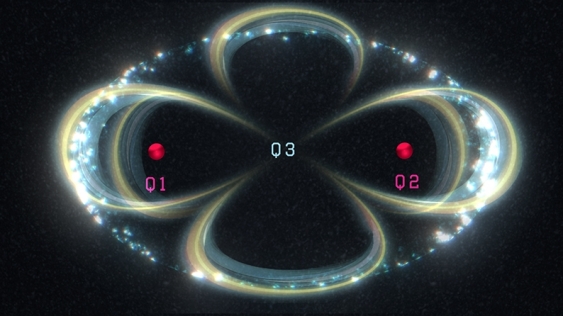2022-01-20 オーストラリア連邦・ニューサウスウェールズ大学(UNSW)

・ UNSW、シドニー工科大学(UTS)およびメルボルン大学が、ほぼエラーフリーのシリコン量子コンピューティングの実現とスケールアップの可能性を実証。
・ イオン注入でシリコンチップに配置した電子 1 個とリン原子 2 個から構成される 3 量子ビットシステムにおいて、単一量子ビットで 99.95%、2 量子ビットで 99.37%の、誤り訂正しきい値を超える操作忠実度を達成した。
・ 既存の半導体製造技術による大規模シリコン量子デバイス開発の道筋を開き、最終目標の汎用型量子コンピューター開発に向けた重要な指針となる。
・ UNSW は過去の研究において、核スピンを極度に分離させることでシリコンでの 35 秒間の量子情報保持を実証しているが、量子コンピューティングに必要な相互作用が不可能となっていた。
・ 今回、リン原子の原子核 2 個を取り囲んだ電子のスピンを通じた、電子と原子核 2 個による 3 量子ビットでの量子もつれ状態を実現。あらゆる計算問題に対処できるユニバーサル操作を可能にする。
・ コア量子プロセッサの核スピンと量子もつれ状態にある電子が、離れた場所にある別の電子ともつれ状態となり、これを繰り返すことで量子ビットの大規模なアレイを形成できる。
・ シリコン量子コンピューター開発では、別途、オランダ・デルフト工科大学(TU Delft)がシリコンとシリコン・ゲルマニウム合金(Si/SiGe)量子ドットの電子スピンを用いて単一量子ビットで 99.87%、2 量子ビットで 99.65%の操作忠実度を、また、理化学研究所は Si/SiGe 量子ドットの 2 電子スピンシステムでの単一量子ビットで 99.84%、2 量子ビットで 99.51%の操作忠実度をそれぞれ達成している。
・ UNSW と TU Delft の各研究での量子ゲート忠実度の定量化と向上には、米国サンディア国立研究所と UNSW が共同開発して一般に公開されている、ゲートセットトモグラフィー(GST)を利用した。
・ UNSW-UTS コンソーシアムは、米国国防総省(DoD)の Next Generation Technologies Fund を通じて資金を受けたオーストラリアと米国間の大学研究イニシアティブ、AUSMURI プロジェクトの一環として設立。同プロジェクトの目標は、マルチ量子ビットシステムを用いた量子ゲート誤りの低減。
・ 米国陸軍研究所(ARL)と ARC Centre of Excellence for Quantum Computation and Communication
Technology もまた、UNSW とメルボルン大学のプロジェクトを支援した。
URL: https://newsroom.unsw.edu.au/news/science-tech/quantum-computing-silicon-hits-99-
cent-accuracy
<NEDO海外技術情報より>
(関連情報)
Nature 掲載論文(アブストラクトのみ:全文は有料)
Precision tomography of a three-qubit donor quantum processor in silicon
URL: https://www.nature.com/articles/s41586-021-04292-7
(関連情報)
サンディア国立研究所開発 Gate Set Tomogoraphy(GST) (1/19)
How Sandia Labs is revealing the inner workings of quantum computers
URL: https://newsreleases.sandia.gov/precision_tomography/
Abstract
Nuclear spins were among the first physical platforms to be considered for quantum information processing1,2, because of their exceptional quantum coherence3 and atomic-scale footprint. However, their full potential for quantum computing has not yet been realized, owing to the lack of methods with which to link nuclear qubits within a scalable device combined with multi-qubit operations with sufficient fidelity to sustain fault-tolerant quantum computation. Here we demonstrate universal quantum logic operations using a pair of ion-implanted 31P donor nuclei in a silicon nanoelectronic device. A nuclear two-qubit controlled-Z gate is obtained by imparting a geometric phase to a shared electron spin4, and used to prepare entangled Bell states with fidelities up to 94.2(2.7)%. The quantum operations are precisely characterized using gate set tomography (GST)5, yielding one-qubit average gate fidelities up to 99.95(2)%, two-qubit average gate fidelity of 99.37(11)% and two-qubit preparation/measurement fidelities of 98.95(4)%. These three metrics indicate that nuclear spins in silicon are approaching the performance demanded in fault-tolerant quantum processors6. We then demonstrate entanglement between the two nuclei and the shared electron by producing a Greenberger–Horne–Zeilinger three-qubit state with 92.5(1.0)% fidelity. Because electron spin qubits in semiconductors can be further coupled to other electrons7,8,9 or physically shuttled across different locations10,11, these results establish a viable route for scalable quantum information processing using donor nuclear and electron spins.



